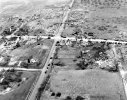That newspaper clipping from 20 April 1920 is remarkable. Apparently the New Deemer F4 dug half-foot-deep “trenches” and hurled mature trees tens of yards (more?), just like the Philadelphia EF5 in ‘11. It also swept homesites clean of sizeable debris. According to Thomas P. Grazulis’ description in Significant Tornadoes, that tornado bisected Neshoba County and tracked along the southernmost edge of Philadelphia, whereas the EF5 of 27 April 2011 developed on the northern outskirts of Philadelphia, but otherwise both tornadoes’ paths roughly paralleled each other’s. In every other respect these events appear to be possible clones, based on forensic evidence, including extensive debarking of trees. The Waco and Brownsboro F4s in Alabama on the same date, along with the Meridian F4 in MS, also produced extreme damage to mature oaks and pines. Detailed descriptions of damage from the 1932 outbreak are more sparse than in 1920, but personally, I am willing to bet that both 20 April 1920 and 21 March 1932 each featured at least one (E)F5.
Regarding 21 March 1952: once again, the official records seem to be largely incorrect. The conditions on that date were supportive of multiple long-trackers, and several of the “brief” tornadoes belonged to the same family, so I suspect that several of the short-tracked spin-ups on that date were actually the same tornado. For example, the tornadoes at England, Tollville, and Cotton Plant are listed separately in the official database, as are the tornadoes at Hickory Plains, Georgetown, and Hickory Ridge, but Significant Tornadoes links each of these, respectively, to singular, long-lived F4s, each with path lengths of sixty-five to seventy miles. The first long-tracker struck the northwest side of England, passed near Tollville and Hazen, devastated the outskirts of Cotton Plant, and then struck Hillemann before dissipating, though it may have continued even farther. The second long-tracker touched down near Wattensaw and tracked through Hickory Plains, Georgetown, McCrory, and Hickory Ridge before dissipating near Fisher. Several of the brief touchdowns in MO and TN are also listed as long-tracking F2+ tornadoes in Significant Tornadoes.
Sayler Park actually appears to be more intense than I recalled: some trees in the image (upper left) appear to have been totally debarked.
For the Plains, I would also consider 27 April 1912, 5 May 1960, 20 May 1949, 13 March 1990, 26 April 1991, 3 May 1999, and 24 May 2011 to be local “Super Outbreaks.”













